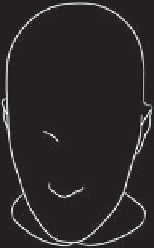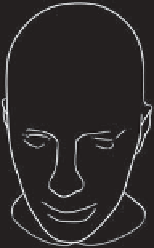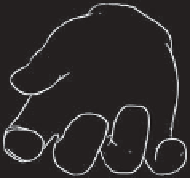Graphics Reference
In-Depth Information
Figure 34.17: Contours of two shapes (left) together with suggestive contours (right).
(Courtesy of Doug DeCarlo. ©2003 ACM, Inc. Reprinted by permission.)
Suggestive contours
are the places where the radial curvature is zero, with
the additional constraint that the derivative of
κ
r
,inthe
w
direction, must be pos-
itive (i.e., if we move from
P
to
P
+
w
(
P
)
, and then project the resultant point
back to the surface and call it
Q
, then
κ
r
(
Q
)
must be positive for small enough
values of
). DeCarlo et al. use the term “suggestive contour generator” for these
points, restricting “suggestive contours” to what we would call “visible sugges-
tive contours.” Suggestive contours can be characterized in two other ways. First,
they are local minima of
n
·
v
in the
w
direction; if we consider ordinary contours
as places where
n
v
got closest to zero before increasing again. This is closely related to the second
characterization: If we move the eyepoint
E
, the contours appear to slide along
the surface (think of the edge of night moving along the Earth as it rotates). But
sometimes, in the course of such a motion, a new piece of contour appears; points
of that new contour lie on the suggestive contour for the original eyepoint. As
DeCarlo et al. describe it, suggestive contours are “those points that are contours
in 'nearby' viewpoints, but do not have 'corresponding' contours in any closer
views.” In short, they might be characterized as places that are almost contours,
or, if you prefer, as places that, if the surface were lit by a light source near the
eyepoint, would be at the boundary between dark and light. As such, they are
natural places to put lines to help indicate shape (see Figure 34.17).
·
v
is zero, then suggestive contours are the points where
n
·
In the examples discussed so far, there are a range of characteristics: Contours are
view-dependent, while ridges and valleys are view-independent (except that we
only draw the visible ones, of course). Suggestive contours are view-dependent as
well, while capturing some of the “where do we expect to see lines?” character: If






